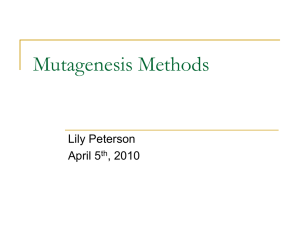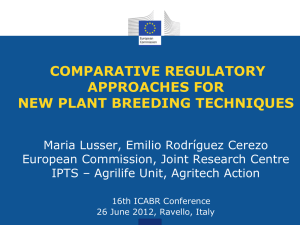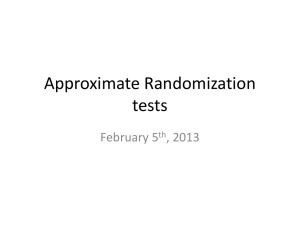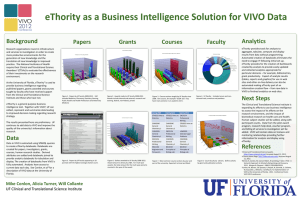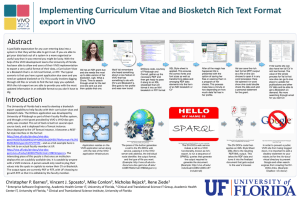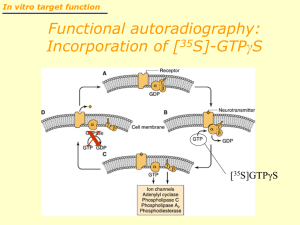Directed Evolution of a Fungal Peroxidase
advertisement
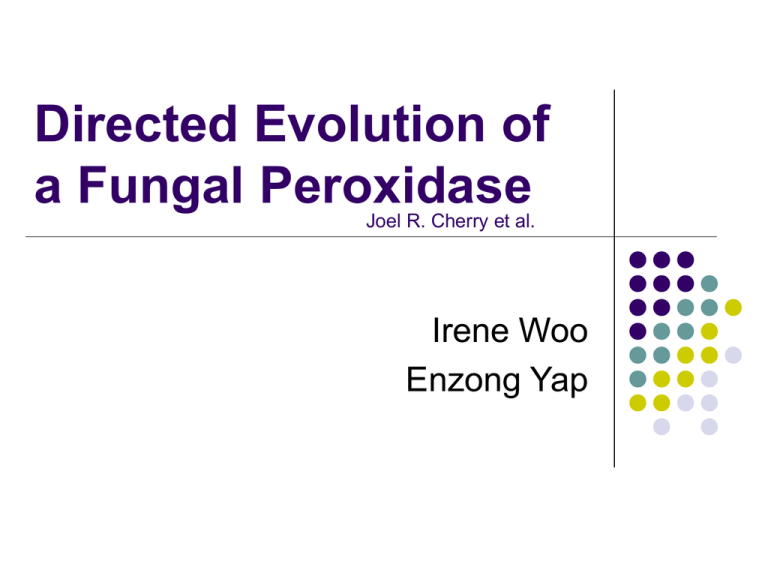
Directed Evolution of a Fungal Peroxidase Joel R. Cherry et al. Irene Woo Enzong Yap Question Explain the difference between initial activity and residual activity. Presentation Outline Introduction Methods and Results Primary Rounds of Random Mutagenesis Site-specific Randomization Secondary Round of Random Mutagenesis Primary Round of In Vivo Shuffling of Mutations Secondary Round of In Vivo Shuffling Discussion Q&A What is Directed Evolution? • Genetically alter enzymes to improve their performance under application-specific conditions Coprinus cinereus (CiP) Heme Peroxidase Removes H2O2 created by Superoxide dismutase 2O2- + 2H- H2O2 + O2 H2O2 H2O + O2 [SOD] [CiP] Peroxidase catalyzes the oxidation of dyes that leach out of colored clothing in the wash rendering them colorless Cyclic Redox Reaction Cyclic Redox Reaction CiP + H2O2 Cpd 1 + H2O Cpd1 + Dye (reduced) Cpd2 + Dye (oxidized) Cpd3 + Dye (reduced) CiP + Dye (oxidized) + H2O Dye (oxidized)= colorless Goal of Directed Mutations Improved stability and activity of the dyetransfer inhibitor CiP peroxidase • Screen with different wash conditions High pH 10.5 High temperature 500C High peroxide concentration 5-10mM How to Create Directed Mutations • • • Mutations are accumulated in successive generations Sequential mutation coupled with random recombination. DNA shuffling Experiment Flowchart Site Directed Mutagenesis (SD) 1st round Random mutagenesis (R1) Site Specific Mutagenesis 2nd round Random mutagenesis (R2) In Vivo Shuffling Presentation Outline Introduction Methods and Results Site Directed Mutagenesis Primary Rounds of Random Mutagenesis Site-specific Randomization Secondary Round of Random Mutagenesis Primary Round of In Vivo Shuffling of Mutations Secondary Round of In Vivo Shuffling Discussion Q&A Site Directed (SD) Mutagenesis http://www.web-books.com/MoBio/Free/Ch9G.htm Site directed mutagenesis to target protein structural features Stability Solvent exposed amino acids – potential unstable sites Salt bridge and disulfides –stabilizing structures Activity Active site charge and accessibility Selection of Mutant Generate Mutations Initial activity assay [ABTS] Enzyme inactivation step (screening/selection) Residual activity assay Initial Activity, %Residual Activity Mutant A Mutant B Initial Activity “mph” 10 POXU/ml 5 POXU/ml Activity after screening/inactivation “mph” Residual Activity “% max speed” 1 POXU/ml 3 POXU/ml 10% 60% POXU where 1 U is the amount of peroxidase required to oxidze one 1umol H2O2 per min in pH7 buffer SD Data Oxidizable residue sites M242I, Y272F, and M166F Destabilizing Interaction E239 Presentation Outline Introduction Methods and Results Site Directed Mutagenesis Primary Rounds of Random Mutagenesis Site-specific Randomization Secondary Round of Random Mutagenesis Primary Round of In Vivo Shuffling of Mutations Secondary Round of In Vivo Shuffling Discussion Q&A Random mutagenesis (R1) Error Prone PCR on wild type genome Identify regions to target distinct from sitedirected mutagenesis Random Mutagenesis 1 Data V53A increased initial activity E239 responsible for increased residual activity Prove by inserting each individual mutation into wild type CiP Presentation Outline Introduction Methods and Results Site Directed Mutagenesis Primary Rounds of Random Mutagenesis Site-specific Randomization Secondary Round of Random Mutagenesis Primary Round of In Vivo Shuffling of Mutations Secondary Round of In Vivo Shuffling Discussion Q&A Site specific randomization Mutations from Site directed mutagenesis [ie: E239K] Mutations from 1st round random mutagenesis [ie: E239G] (NN) GC Substitute amino acid E239A Screening E239 E239G E239R N.B. Different from site directed Best Mutant Site Specific Randomization Results E239 G Plastic Non bulky AA Legend 20 min at pH 10.5 at 23°C (black bars), 23°C + 0.2 mM H2O2 (whitebars), 50°C (striped bars), 50°C + 0.2 mM H2O2 (gray bars). Other Site Specific Randomization with no improvements V53A M166F vs. M166L No improved enzyme activity Improved peroxide stability but no improved thermal stability E214(partner to E239) No improvement in stability Presentation Outline Introduction Methods and Results Site Directed Mutagenesis Primary Rounds of Random Mutagenesis Site-specific Randomization Secondary Round of Random Mutagenesis Primary Round of In Vivo Shuffling of Mutations Secondary Round of In Vivo Shuffling Discussion Q&A 2nd Round Random Mutagenesis (R2) Best combination from site-directed and random mutagenesis [Mutant 072(E239G, M242I, and Y272F)] Error Prone PCR with Mutant 072 Random Mutagenesis 2 Data Improved mutant 072 Increased stability at the cost of reduced activity Presentation Outline Introduction Methods and Results Primary Rounds of Random Mutagenesis Site-specific Randomization Secondary Round of Random Mutagenesis Primary Round of In Vivo Shuffling of Mutations Secondary Round of In Vivo Shuffling Discussion Q&A In Vivo Shuffling Separate the trade off between activity and stability phenotypes Shuffling out deleterious mutations Shuffle the 10 best mutants found from 2nd round of mutagenesis representing a spectrum of activity and stability High Stability Low initial activity High stability High initial activity Low stability High initial activity In Vivo Shuffling Process PCR In Vivo Shuffling Transform into Yeast • Amplify 10 best mutants by PCR • Transform into yeast • Yeast efficiently recombines PCR fragments In Vivo Shuffling inside Yeast Mutant Fragments 3’ 5’ Linearized 5’ vector with homologous ends for recombination 3’ Re-circularized Autonomously Replicating Plasmid pJC106 Advantages of Shuffling Shuffling generates combination of amino acid substitutions that gave even better enzymes than each individual mutants Better odds of finding best combination in mutagenesis library from shuffling than from manual mutagenesis Proof of Concept of Shuffling in Yeast Cells Different silent or signal sequence substitution for 972 and 974 suggest these mutations arose from different recombination events Non-Linked Phenotype Results of In Vivo Shuffling Separation activity and stability phenotypenot linked Mutants 972 and 974 combined the residual activity of the most stable mutant with the initial activity of the most active mutant. Second Round of In Vivo Shuffling Novel 149S/T, V53A, and M166F mutant that acts synergistically-not predicted by site specific randomization Presentation Outline Introduction Methods and Results Site Directed Mutagenesis Primary Rounds of Random Mutagenesis Site-specific Randomization Secondary Round of Random Mutagenesis Primary Round of In Vivo Shuffling of Mutations Secondary Round of In Vivo Shuffling Discussion Q&A Discussion 3/7 including best mutants were not predicted through random and site specific mutagenesis requires in vivo shuffling Found improved stability and activity of the dyetransfer inhibitor under stringent wash conditions : High pH 10.5 High temperature 500C High peroxide concentration 5-10mM Future application Shuffling a family of genes from diverse species Combining protein design ideas with techniques of random discovery Oversights Where did the 10 mutants for in vivo shuffling come from?How was In Vivo Shuffling was done? Assumed we knew the process. Missing important mutants in Table 1 (ie: the novel mutant and mutant with 92% activity found in R2) Q&A
